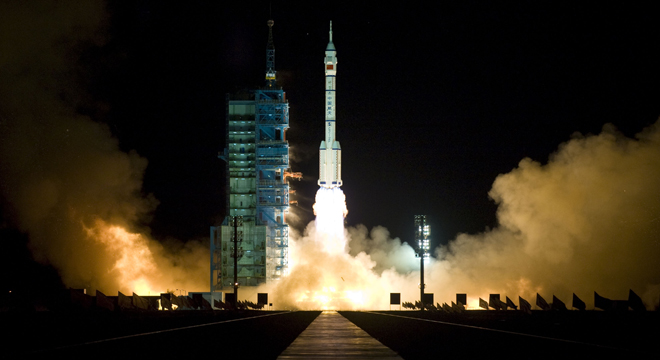China is rocketing towards its goal of building its own national crewed space station by 2020, around the same time that the U.S.-led International Space Station is scheduled to be retired and de-orbited.
On Tuesday, the China National Space Administration successfully launched a rocket carrying its unmanned Shenzhou-8 spacecraft into low-earth orbit, where it is set to rendezvous and dock with the Tiangong-1 module launched in late September, testing the procedures needed to link-up the various components of China’s planned space station.
The Long March 2F rocket blasted off from the Jiuquan Satellite Launch Center in the remote Mongolian desert at 5:58 a.m. local time, November 1, according to Chinese state news agency Xinhua.
The launch, which was broadcast on China Central Television (CCTV) (video below), and the subsequent docking are being watched closely both by observers within the country and around the world, as the mission marks an important milestone in China’s human-crewed space ambitions and an entirely new frontier for the country.
Only the United States, Russia, the European Space Agency and Japan have demonstrated orbital rendezvous and docking technology, according to Spaceflight Now.
“Since we have never conducted a similar test before and the system is so complicated, we have many unknowns,” said Zhou Jianping, chief designer of China’s manned space, in an interview with Xinhua (via Space Daily). “It is highly risky.”
The margin of error in docking the two craft is no greater than 20 centimeters.
Indeed, China is approaching the orbital docking issue from the opposite way that the U.S. did when astronauts Neil Armstrong and David Scott achieved history’s first physical link-up of two spacecraft in orbit, back in 1966.
Instead, the docking of the Shenzhou-8 to the Tiangong-1 will be umanned and automated, echoing the world’s first automated spacecraft docking by the Soviet Union in 1967.
But the U.S. isn’t lending China any assistance on its space ventures and Russia has provided so far minimal support in the form of equipment such as space suits, forcing China to rely, for the most part, on homegrown technologies.
“We can never count on other countries to sell their mature technologies to us, so we have to rely on our own,” Zhou told Xinhua.
That said, for this mission, the German Aerospace Center (DLR) is partnering with China to conduct experiments on the linked spacecraft, including exposing “plants, nematodes, bacteria and human cancer cells” to zero gravity and then parachuting these back to earth for examination.
As the German Aerospace Center noted in a release applauding the launch Tuesday: “This is the first time that the China Manned Space Engineering Office (CMSEO) cooperates with another nation in the use of Shenzhou – the core of China’s human spaceflight programme.”
Shenzhou 8 was naturally preceded by Shenzhou 1 through 7. All the craft are named after a nickname for China itself, “Divine Land,” (“Divine craft”) and share some of the same general design features – three modules (descent, service and orbital), solar panels, a propulsion system and autonomous controls- and are generally similar to the Russian Soyuz, but various improvements have made to each successive craft following the launch of the unmanned Shenzhou 1 in 1999.
The first human-crewed Shenzhou, Shenzhou 5, launched in 2003 carrying Yang Liwei, the first Chinese person in space, or “taikonaut.” Yang went on to become the deputy director general of China’s manned space program.
The last Shenzhou launched prior to Shenzhou-8, Shenzhou-7, launched in 2008 carrying taikonauts Zhai Zhigang, Liu Boming, and Jing Haipeng. The mission saw China’s first successful space walk.
Clearly, China has had quick success in developing its manned space program, but it’s also had its hiccups as well. Just this year, a Long March 2C rocket malfunctioned shortly after takeoff. While the rocket was unmanned and wasn’t carrying equipment related to the manned space program, it was similar to the Long March 2F class of rockets used to launch the Shenzhou and Tiangong-1 into orbit, prompting the launch of the Tiangong-1 to be delayed while Chinese engineers double-checked everything.
The Shenzhou-8 docking procedure seems to be on target, with the spacecraft already opening its solar panels and completing its first change of orbit on Tuesday. The craft is scheduled to conduct several more rocket burns to get it into place to dock with the Tiangong-1 200 miles above the Earth.
We’ll continue to follow the progress of the Shenzhou-8 and Tiangong-1 docking mission and update for major developments. Stay tuned.









